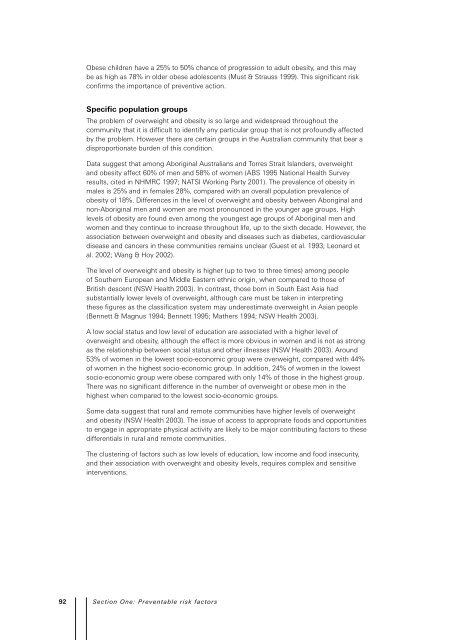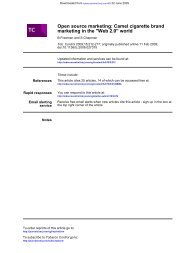National Cancer Prevention Policy - Tobacco Control Supersite
National Cancer Prevention Policy - Tobacco Control Supersite
National Cancer Prevention Policy - Tobacco Control Supersite
You also want an ePaper? Increase the reach of your titles
YUMPU automatically turns print PDFs into web optimized ePapers that Google loves.
Obese children have a 25% to 50% chance of progression to adult obesity, and this may<br />
be as high as 78% in older obese adolescents (Must & Strauss 1999). This significant risk<br />
confirms the importance of preventive action.<br />
Specific population groups<br />
The problem of overweight and obesity is so large and widespread throughout the<br />
community that it is difficult to identify any particular group that is not profoundly affected<br />
by the problem. However there are certain groups in the Australian community that bear a<br />
disproportionate burden of this condition.<br />
Data suggest that among Aboriginal Australians and Torres Strait Islanders, overweight<br />
and obesity affect 60% of men and 58% of women (ABS 1995 <strong>National</strong> Health Survey<br />
results, cited in NHMRC 1997; NATSI Working Party 2001). The prevalence of obesity in<br />
males is 25% and in females 28%, compared with an overall population prevalence of<br />
obesity of 18%. Differences in the level of overweight and obesity between Aboriginal and<br />
non-Aboriginal men and women are most pronounced in the younger age groups. High<br />
levels of obesity are found even among the youngest age groups of Aboriginal men and<br />
women and they continue to increase throughout life, up to the sixth decade. However, the<br />
association between overweight and obesity and diseases such as diabetes, cardiovascular<br />
disease and cancers in these communities remains unclear (Guest et al. 1993; Leonard et<br />
al. 2002; Wang & Hoy 2002).<br />
The level of overweight and obesity is higher (up to two to three times) among people<br />
of Southern European and Middle Eastern ethnic origin, when compared to those of<br />
British descent (NSW Health 2003). In contrast, those born in South East Asia had<br />
substantially lower levels of overweight, although care must be taken in interpreting<br />
these figures as the classification system may underestimate overweight in Asian people<br />
(Bennett & Magnus 1994; Bennett 1995; Mathers 1994; NSW Health 2003).<br />
A low social status and low level of education are associated with a higher level of<br />
overweight and obesity, although the effect is more obvious in women and is not as strong<br />
as the relationship between social status and other illnesses (NSW Health 2003). Around<br />
53% of women in the lowest socio-economic group were overweight, compared with 44%<br />
of women in the highest socio-economic group. In addition, 24% of women in the lowest<br />
socio-economic group were obese compared with only 14% of those in the highest group.<br />
There was no significant difference in the number of overweight or obese men in the<br />
highest when compared to the lowest socio-economic groups.<br />
Some data suggest that rural and remote communities have higher levels of overweight<br />
and obesity (NSW Health 2003). The issue of access to appropriate foods and opportunities<br />
to engage in appropriate physical activity are likely to be major contributing factors to these<br />
differentials in rural and remote communities.<br />
The clustering of factors such as low levels of education, low income and food insecurity,<br />
and their association with overweight and obesity levels, requires complex and sensitive<br />
interventions.<br />
2 Section One: Preventable risk factors




